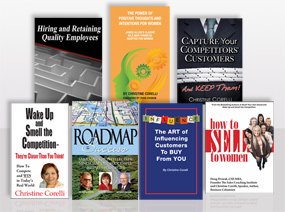
How to Hold an Effective Corporate Retreat
Corporate retreats represent a significant investment of time and energy. Many companies refrain from holding them because they are regarded as time consuming. However, conducted properly, corporate retreats can be the best overall investment companies can make.
Regardless of the size of your company or the type of business you own or manage, the bottom line is that bringing key people together for a corporate retreat is a smart move. A retreat is an excellent opportunity for strategic planning, and to make decisions on what actions you need to take to increase your sales, establish higher levels of customer loyalty, improve overall performance, and drive business growth.
Effectively planned and executed, a corporate retreat is an excellent platform for reinforcing leadership skills, brainstorming ideas, solving problems, stimulating teamwork, nurturing a sense of camaraderie, and clarifying and reaffirming your organization’s competitive strategy.
Corporate retreats are valuable experiences and they are fast becoming one of the most effective management tools a company can use. Since people tend to promote what they help to create, a carefully planned retreat will ensure that everyone in your organization will support corporate decisions.
Tips on Planning a Successful Corporate Retreat
The following are twenty one tips to assist you in planning a successful corporate retreat.
21 Tips for planning a successful corporate retreat…
1. Be clear on what you want your corporate retreat to accomplish.
Specifically, answer these two questions—What has to happen to consider this corporate retreat a success? What specific issues or topics do you want to discuss?
2. Have the right people on your corporate retreat team.
No more, no less. Remember, this is not a reward or a popularity contest. If you don’t have the right players, your corporate retreat will not be productive. The next tip may help you to designate the retreat team.
3. Decide whether you want to invite only your executives or include your managers and a few key people to be on your retreat team.
Consider the benefits of including managers and few high-contributing employees. If you choose to do so, invite employees with strong leadership skills who possess an in-depth knowledge of the issues at hand so they can participate—even for a portion of your corporate retreat agenda.
Prior to the event, ask them to poll their staff on the following issues/topics for discussion at the retreat. They will have great insight to bring to your retreat that provides input, shares ideas, and represents the voice of the people in their department. You’ll be surprised at what you might learn.
-
What is our company doing exceptionally well?
-
What are you hearing from our customers?
-
What do you need from management to perform your job more effectively?
-
How can we improve teamwork, communication, and morale?
-
What ideas do you have to help the company move forward?
-
If you could change one thing, what would it be?
4. Name your employee team.
If you make the decision to invite just a few employees, give them a name, such as the “President’s Advisory Team,” or “Acme Leadership Council, or “Acme Future Leaders Council.” It will demonstrate that you recognize their leadership ability and will make them feel important and appreciated.
5. Establish your objectives.
While every organization has its own unique challenges, the following are examples of areas for discussion that you might address:
-
What is our company doing exceptionally well?
-
What do our customers want, need, and expect from us?
-
How well do we deliver what our customers want, need, and expect?
-
What are our customers saying about us?
-
Do we deliver on our brand promise?
-
How are we perceived in the eyes of our industry and community?
-
What complaints do we hear from our customers?
-
What service flaws exist and how can we avoid or eliminate them?
-
How can we streamline our operations and cut red tape?
-
What processes or procedures do we have that don’t make sense and hold us back from flawless execution?
-
What can we do to become the Number One preferred provider?
-
How can we help our sales force to generate more sales and establish higher levels of customer loyalty?
-
What new approaches can we take to our advertising and marketing strategies?
-
What are the trends occurring in our industry that will impact our decisions?
-
Where could we expand our business and tap into new markets?
-
What is the overall level of performance of our employees?
-
Do they act as our brand ambassadors?
-
Who are our highest contributors?
-
Who needs more coaching and skill development?
-
Who is not performing and may need more help or even be terminated?
-
What more can our employees do to better support our sales team?
-
Do our employees have the skills, tools, and training they need?
-
What, specifically, can we do to create higher levels of customer loyalty and turn our customers into advocates?
-
Where do we need improvement?
-
How can we take what we’re doing right and use these to build on our strengths?
- Add questions relevant to your company.
6. Set a tightly focused agenda.
Select no more than three topics for discussion; consider that most urgent issues. If you try to cover too much, in too little time, you will not be satisfied with the end result. Stay on track. Don’t let anyone ramble on during discussions.
7. Provide materials for review.
Distribute copies of a great business book (From Good to Great, or Wake Up and Smell the Competition are excellent choices) or a magazine article on future trends in your industry, advertising and marketing techniques, sales strategies, employee motivation, or any topic related to your most urgent needs. Ask attendees to review the materials prior to your corporate retreat to be able to share what they learned from it and how you can apply it to your company.
8. Bring information.
Before the management retreat, ask your team to gather new information or “intelligence” about your business and your competitors.
9. Keep it quiet.
Keep in mind that the Encarta World English dictionary defines a retreat as…
a period of quiet rest and contemplation in a secluded place. Or…
a period away from normal activities, devoted to contemplation
Whether you want to work together for three days, or you can only spare one day, the best place for your corporate retreat is a quiet atmosphere far from the hustle and bustle of daily business. It doesn’t have to be an expensive resort or a fancy country club — especially if you don’t want your people looking out the windows and checking their watches because they’re anxious to play golf. (If you do want to play golf or engage in another team building recreational activity, schedule it into your corporate retreat accordingly.)
10. Keep it simple and inexpensive if budget is a concern.
Money is not the key component in a successful corporate retreat. Some highly productive retreats have even been held in an executive’s backyard or at a quiet restaurant with a meeting room. Consider holding your retreat in a simple meeting room, or at a country bed and breakfast inn (with an appropriate private room for your sessions plus a dining room for breaks).
By way of example, a company located in Connecticut invited twelve of its top leaders to a special retreat at a quaint bed and breakfast located on a lake. Check-in was Friday morning and the first session was scheduled for Saturday morning. After a good dinner and a quiet restful evening, they all met early— fresh and eager to begin the sessions, which were held in a quiet meeting room in the facility.
What Might Be Most Important at a Corporate Retreat
Although their managers had already been through an extensive leadership training program, the executive who organized the management retreat stated his position to a professional speaker he invited to the management retreat.
“We can never hear enough about leadership.
Let’s kick off our management retreat with a reinforcement
of leadership skills.”
The speaker delivered a program that would help reinforce their leadership skills. Her forty-five minute presentation was upbeat and highly interactive, because it is critical to maintain high energy levels and a great deal of involvement at any corporate retreat for it to be successful.
Then, she conducted a corporate retreat team-building exercise, followed by a quick review on the team communication skills below to apply during their discussions.
1. Open communication
2. Monitor Communication — Inclusion, Clarification
3. Brainstorming-Idea Sharing
4. Decision Making
She instructed the retreat team to look at their company with the eye of an outside consultant. The corporate retreat team proceeded to work for six hours, including a working lunch and twenty-minute breaks. In the late afternoon, everyone was given some free time. Some napped; some played golf; some went walking in town. In the evening, a quiet dinner was held at a lovely restaurant. The rule at dinner was no business chat!
The next morning, discussions continued. Final decisions were made in the afternoon. Each team member was instructed to develop an action plan to make a strategy work.
11. Consider more options for your corporate retreat format.
Some companies use this type of format:
Day One: Arrival is in the early afternoon, with an early dinner planned. During the dinner, teams of two, three, or four are formed, depending on how many people attend the retreat. Each team is given an assignment from one of the three areas you have selected for retreat discussion. They meet together for an hour to discuss the topic. Then, together, they create a 20-minute presentation that will include the following:
1. Your strengths
2. Your needs
3. Your challengesOne person is selected to deliver the presentation to the group. Many may want to use PowerPoint to make a better impact. Later that evening, your retreat team reconvenes as a group and listens to the presentations.
Day Two: Discussions are conducted. Decisions are made and an action plan is developed.
Some companies have retreats that last an entire weekend. Whatever you decide, make sure it is an energizing experience for your corporate retreat team.
12. Consider engaging the services of a high-powered corporate retreat facilitator.
While it’s possible for you, or anyone in your company, to conduct the retreat, you will often get better results if you bring in a business expert who is an experienced corporate retreat facilitator to provide ideas and accomplish your retreat goals. A retreat facilitator is neutral and can see conflicts/opportunities that your retreat team might not see and can share ideas from other companies.
An experienced corporate retreat facilitator is a strong communicator, keeps everyone focused, and knows how to read body language. He or she responds to what they see and hear. The facilitator knows how to obtain participation from every member of the group. Prior to your retreat, the expert will conduct research on your industry, talk to your customers, and consult with your company to identify issues and challenges and find out what is going on in your employees’ minds. The facilitator will report the findings at the retreat and help you problem-solve.
Another good reason to bring in a corporate retreat facilitator is to ensure no single individual has to wear two hats. Past experience has proven that the company person should not have to worry about being both a facilitator and a participator.
An outside person will not be influenced by your management structure. In fact, a good facilitator will help you create ground rules for the retreat – the first being the next tip.
13. Everyone leaves their hats and their titles at the door.
At one executive retreat, the company president stated, “Okay, folks, at our last retreat you told me I needed to do a better job of communicating. How have I been doing lately?” How honest and forthright a statement coming from a top-level executive! The next rule follows.
14. No cell phones or e-mail communication during the retreat.
If your corporate retreat will be held during the week, set half-hour breaks for phone calls.
15. Use subtle background music to enhance creative-thinking.
Studies have proven that people think more creatively when classical music is playing in the background. Mozart, Vivaldi, Bach, can be superb choices. Just make sure the volume is low and the music is instrumental.
16. Refrain from rewards.
Never use a corporate retreat to award someone. Your time must be spent on idea sharing and problem-solving.
17. Ensure that “follow through” is part of your executive retreat process.
When you conclude, be prepared to make final decisions and create assignments. Make sure expectations are clarified and that you analyze your results.
18. Evaluate.
Finally, ask for a candid evaluation from your participants. Make sure you include the question, “How can we improve our next management retreat?” Determine whether they come away with what you had anticipated when the retreat was originally planned.
19. Execution is critical. Make sure your entire corporate retreat team knows that
Going Back to “Business As Usual” Won’t Cut it.
Execution Must Be Your Competitive Strategy
20. Retreat Repeatedly.
Many companies hold a yearly corporate retreat, while others hold them quarterly, to make sure their leadership functions as a unified team and stays on track. Others hold a retreat just prior to an annual employee meeting. Still others hold them sometime in late fall or early winter, so they can put their strategy into place and make announcements early in the New Year.
21. Hold a Corporate Retreat or Management Retreat now.
You’ll be amazed at what you can accomplish at a corporate retreat if you’ve never held one, or if you’ve never held them in the right manner. Just keep this in mind: Holding a retreat doesn’t have to be costly. Holding a retreat with the right structure, format, and facilitator is not an unnecessary expense, but an investment that is well worth making.
(Note: Graphic courtesy of Cindy Phillips, Sales Strategist, Shade-O-Matic.

